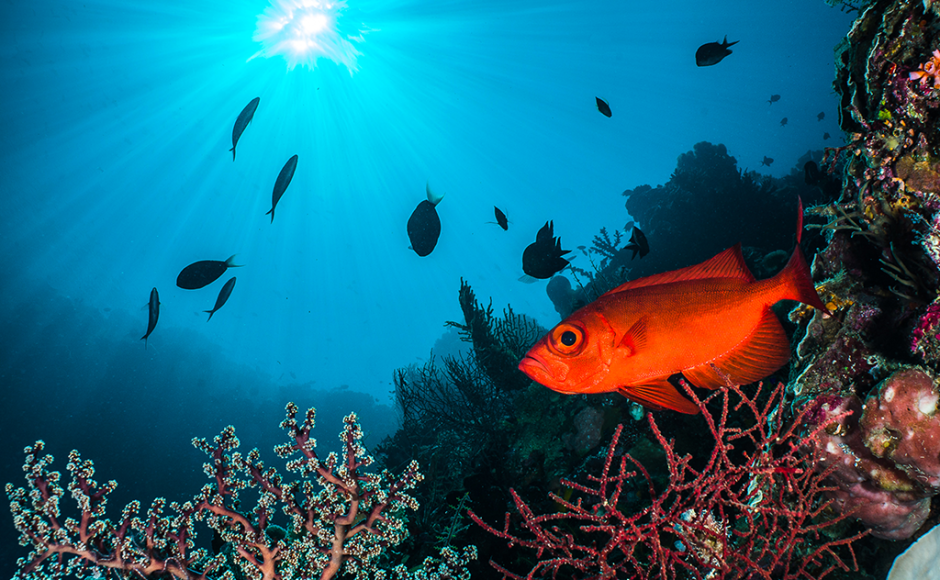Bold Statements
Coral reefs are places of great beauty. But the tranquil appearance can be deceiving, as there are dangers everywhere for those who live among the corals. Reef communities are among the most densely populated environments on the planet. When predator and prey live so closely together, survival strategies become very important.
Those who are built for speed can often survive by remaining vigilant and ready to flee. But what about those who move more slowly, or not at all? They can’t spend their won lives in hiding. Instead, these reef dwellers have created a number of physical and behavioral adaptations that allow them to go about the business for acquiring nourishment and reproducing without becoming food for something else in the process.
Some of the most interesting adaptations are also some of the most visually captivating; creating bold statements to other marine creatures to “back off” or something bad might happen. The range and depth of some of these anti—predation tactics and defenses can be highly visual and exceedingly deceptive. Following are a few examples of these bold statements.
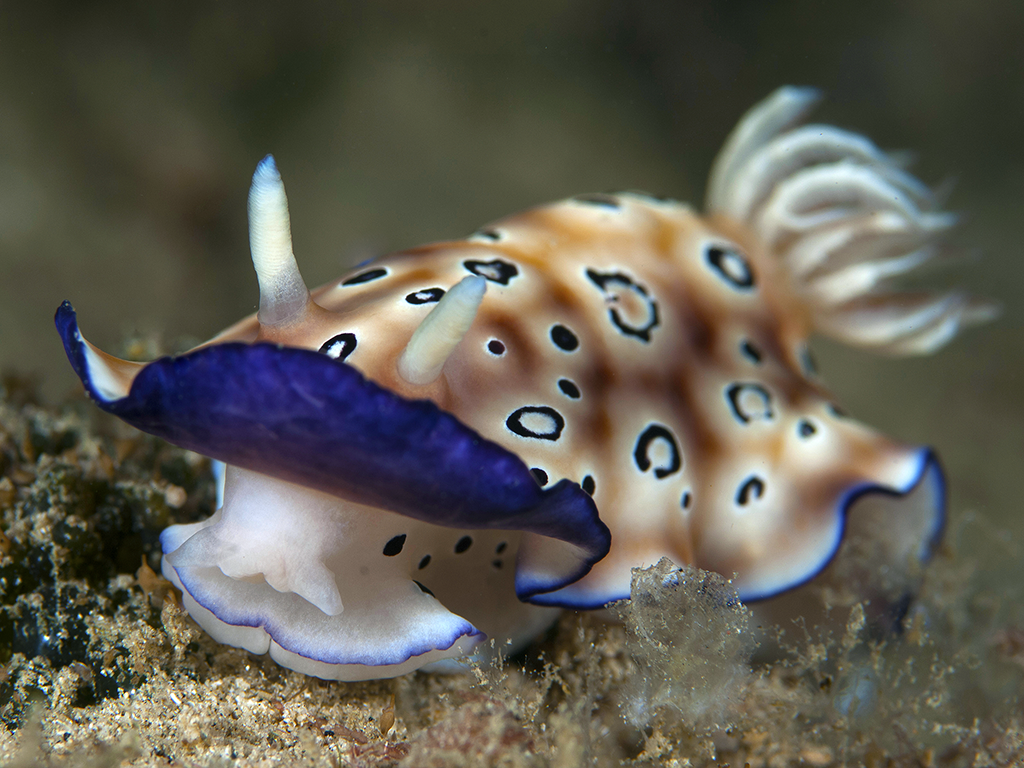
Sometimes a pretty package doesn’t necessarily mean an invitation. For example, one taste of this dorid nudibranch (Hypselodoris tryoni) is more than sufficient to teach a predator that it is a bitter mouthful to covet. Scientists believe that the natural toxins produced by reef invertebrates such as these may have future commercial or medicinal applications. Photo by Richard Smith, www.facebook.com/OceanRealmImages
 |
|
Some species of nudibranchs like this pretty little Cuthona are biological burglars; they will borrow the defense mechanism from one animal and use it for themselves. Photo by Steve Miller, www.ikelite-photoschool.com.
Nudibranchs that feed on hydroids can store the hydroids’ stinging cells (nematocysts) within their own body, primarily in the cerata (the wavy little appendages on their back). So if an unsuspecting fish were to attempt to eat these nudibranchs they would get a mouthful of stinging cells instead of a delectable treat. To advertise this trait, nudibranchs are among the most flamboyantly colored creatures on the reef — their way of waving the red warning flag, even if it should happen to be in Technicolor.
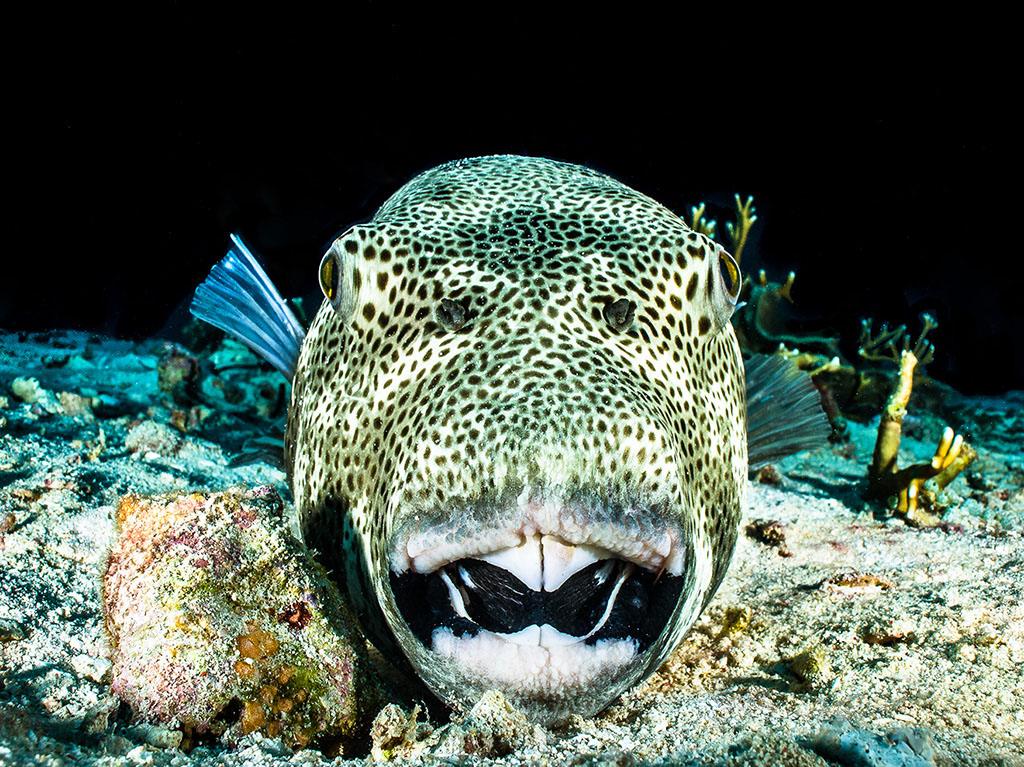
We all love the looks of a pufferfish when it pumps up like a squeeze toy; even giant pufferfish, like this one, are cute and cuddly when they show their toothy grin. But have you ever wondered why such adorable, slow moving fish are not on everyone’s dinner menu? When the fish inflates, it becomes difficult for a predator to fit the puffer into its mouth. Photo by Wayne MacWIlliams
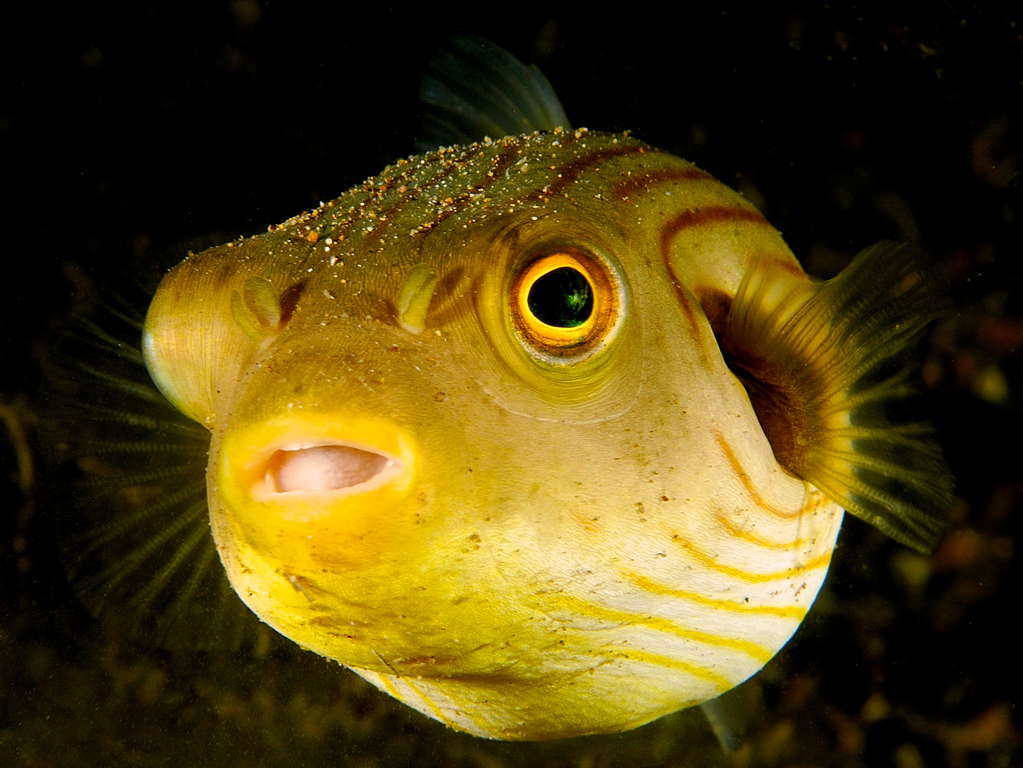
Some puffers have pointed spines, even if they are not visible until inflated. Photo by Steve Miller, www.ikelite-photoschool.com
A hungry predator may suddenly find itself facing an unpalatable pointy ball rather than a slow, tasty fish. Even if a predator manages to get one down its throat, it still may find it got more than it bargained for. Many puffers also contain a neurotoxin that can be lethal or at the least highly unpleasant to anyone who eats it.
Unfortunately, according to many reputable sources, puffing up too often can be very stressful to the pufferfish. So, as marine life lovers and photographers we must respect these wondrous creatures and not create undo stress by keeping our distance, even when we think it might be ok.

An individual blue-ringed octopus will use its dermal chromatophore cells to camouflage itself until it is provoked, at which point it quickly changes color, becoming bright yellow with blue rings or lines. Photo by Steve Rosenberg
A small octopus out in the open will make a nice meal for just about any predator on the reef, unless of course it happens to be a blue-ringed octopus. An individual blue-ringed octopus will use its dermal chromatophore cells to camouflage itself until it is provoked, at which point it quickly changes color, becoming bright yellow with blue rings or lines.
This little beauty also packs a highly potent neurotoxin in its bite that can quickly neutralize anything up to a hundred times its size. To advertise this lethal feature, the blue-ringed octopus displays it’s unmistakable iridescent blue rings and lines, which glow stronger and brighter as the animal perceives a threat.
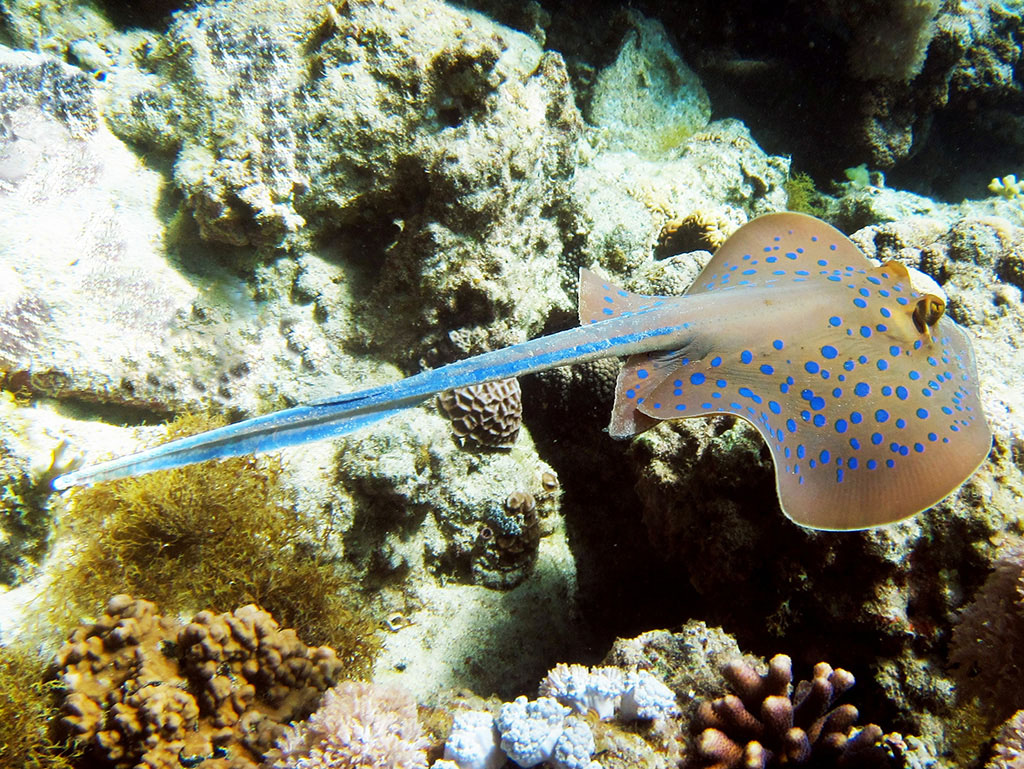
Stingrays come equipped with a serrated barb on the base of their tail, which they use as a means of defense. Photo courtesy Wakatobi Dive Resort
When they’re young, bluespotted stingrays are covered with iridescent blue spots. Predators such as the hammerhead shark are known to frequently prey on the bluespotted stingray. But the ray’s coloration is an alert signal for its poisonous barb, so few animals attempt to overpower it. Borrowing the playbook from the blue-ringed octopus, their striking blue spots serve as a warning to other fish — don’t mess with me!
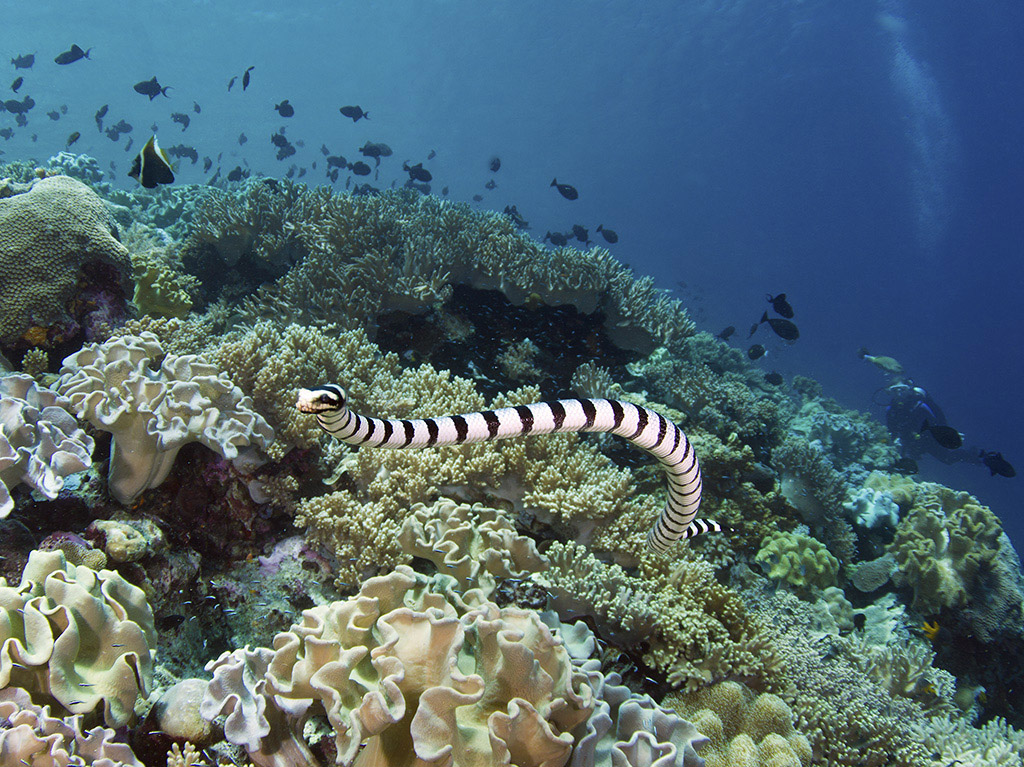
Black-banded sea krait. Photo by Walt Stearns
The black-banded sea krait has a shimmering banded color pattern that says: “watch out.” This marine reptile moves too slowly to catch fish in a straight chase, so its tactic is to corner fish such as gobies, blennies and damselfish where they hide down in the coral.
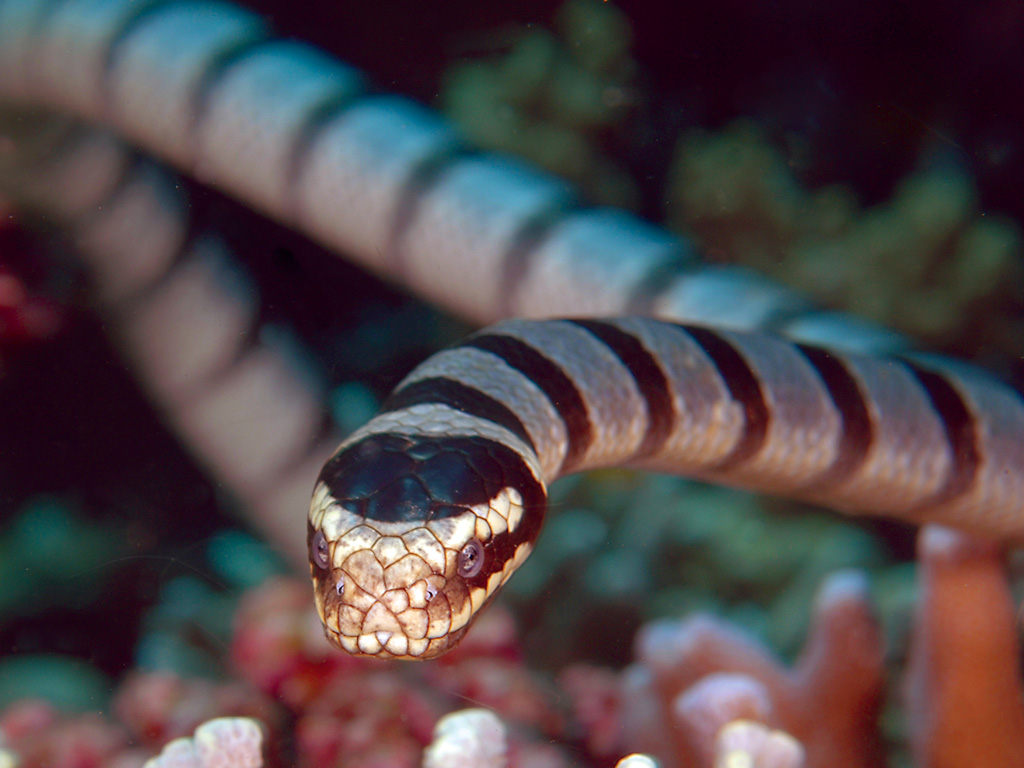
Like all sea snakes, the krait’s bite instantly paralyzes prey, as the venom is ten times stronger than that of a cobra, making them extremely dangerous. Fortunately, this snake tends to ignore humans, and does not bite unless it feels threatened. Photo by Gal Goyen

The brilliant colors seen on healthy reefs such as those at Wakatobi can also mean “look, but don’t touch.” Photo by Warren Baverstock, www.warrenbaverstock.com
Healthy coral reefs are like vibrantly colorful gardens. But these colors can mean “look, but don’t touch.” A mere brush of the wrong place, for divers and marine life alike, can teach a painful lesson in the dangers of contact. Cnidarians, which includes corals, hydroids, jellyfish, sea anemones and black corals, all possess stinging organelles called nematocysts, which they use for defensive purposes. While they are quite beautiful to look at, they can pack a sharp, and sometimes, deadly punch.

Cnidoblasts, which give the corals phylum its name “Cnidarian,” are located in the coral’s feathery tentacles. Photo by Wayne MacWilliams
Many soft corals have many microscopic stinging cell filaments or cnidoblasts, which give the phylum its name of “Cnidarian.” These cnidoblasts are located in the coral’s feathery tentacles, and produce minute stinging capsules with a threadlike organ–effectively a mini harpoon–that can be shot out to either attack prey or ward off threats.
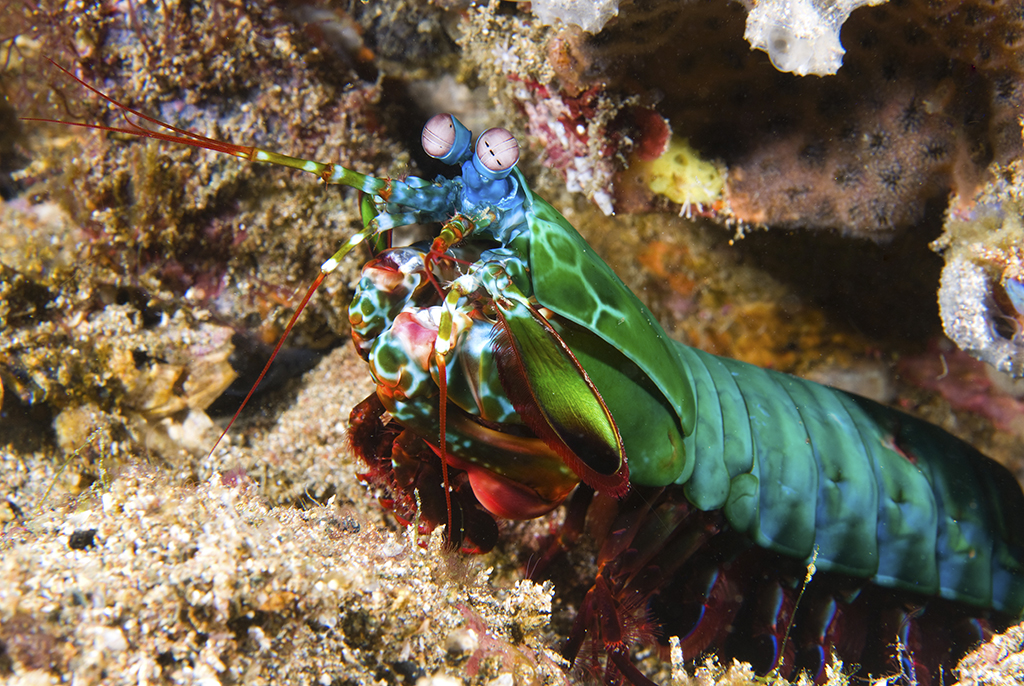
Think twice about adding the Mantis shrimp to the menu. They’re pretty to look at, but their club-shaped appendages, used to capture prety with a single strike, pack the fastest recorded punch of any living animal. Photo by Walt Stearns
Ready to deliver that knock down punch? Flamboyantly colored like their namesake bird, the peacock mantis shrimp are fearless, active hunters. Resembling peacock feathers, their extravagant club-shaped raptorial appendages are used to dispatch prey with a single strike, which can be delivered at speeds of over 50 miles per hour (80 km/h). This is the fastest recorded punch of any living animal, with an acceleration rate equivalent to that of a .22 caliber handgun, and an impact force of 200 pounds per square inch.
The surface of the mantis’ striking appendage is made up of extremely dense hydroxyapatite, layered in a manner that is highly resistant to fracturing. You had better think twice about adding this shrimp to the menu. They may look pretty, but they will hit you like a bullet.

Scorpionfish up close and personal. Photo by Richard Smith, www.facebook.com/OceanRealmImages
Most members of the family Scorpaenidae, or scorpionfish, rely on camouflage as a means to hunt, but use weaponry that involves chemical warfare (toxins) for defense. As the name suggests, scorpionfish can sting with sharp spines coated with venomous mucus. The family is a large one, with hundreds of members, most of which are found in the Indo-Pacific. Once in a while you will find one that does not follow the basic earth tones for coloration but instead seems to say “Hey, look at me.”
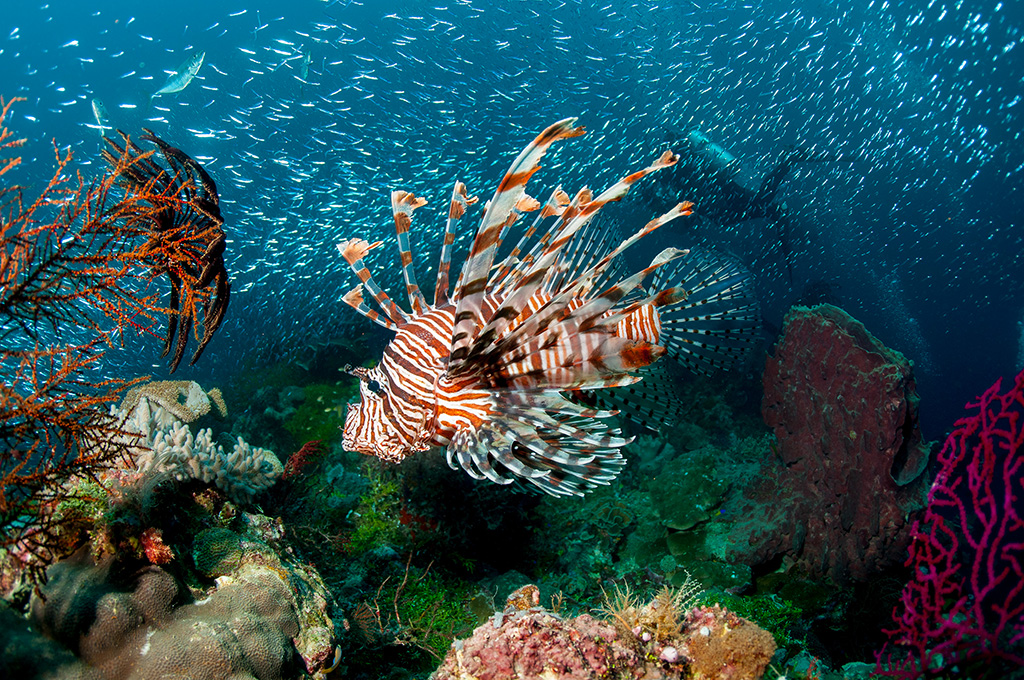
The red lionfish is one of the most beautiful fish on the coral reef, and perhaps the most widely recognized of all lionfish. Photo by Alan Saben
Coral reef fish are among the most elaborately ornamented animals on earth. But for marine creatures, their flashy exterior is not only for show. The red lionfish is one of the most beautiful fish on the coral reef, and perhaps the most widely recognized of all lionfish. Their vividly contrasting coloration is intended as a warning to other predators. Their “don’t care” attitude makes the red lionfish easily approachable for photography–just be sure to watch out for its venomous spines.

Shortfin lionfish. Photo by Rodger Klein
While not as large as a red lionfish, the dwarf lionfish, or shortfin lionfish, is no less spectacular. Like other members of the Scorpaenidae family, the venomous spines are not only potent, but well advertised for the benefit of any attackers having the misguided intention of making this colorful morsel a meal.

The twinspot is a secretive little lionfish that exhibits some interesting behavior. Photo by Richard Smith, www.facebook.com/OceanRealmImages
The twinspot lionfish is easily separated from other species in its pride by the eyespots on the dorsal fin and its Fu-Manchu moustache. The eyespots may serve to dissuade large fish-eating predators from messing with it. If that does not stop a predator from trying to eat it, its toxic dorsal spines might. Still scorpionfishes such as the twinspot, are sometimes eaten by sharks, morays, and even frogfishes.
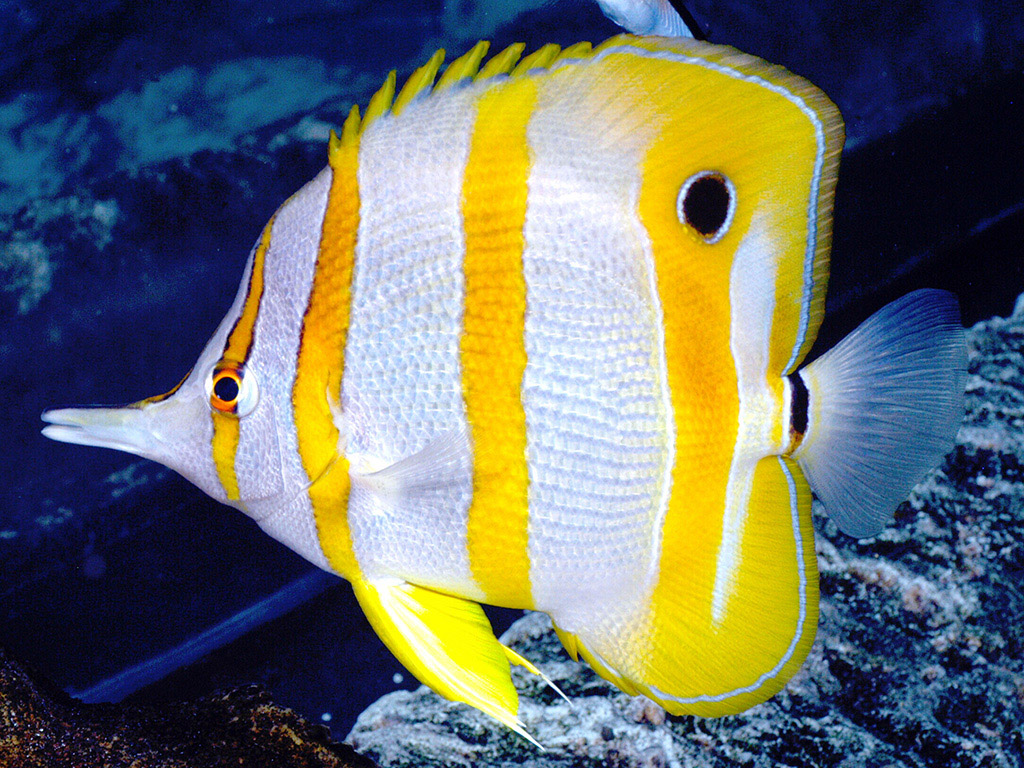
Copperband butterflyfish. Photo by Steve Miller, www.ikelite-photoschool.com
Some fish’s defenses are intertwined with their coloration, either in the form of color patterns that blend with their surroundings, or one that says out load “I am not the one to mess with,” like this Copperband butterflyfish.
But, there are also those who rely on false advertising by clearly stating they are something they are not. They achieve this by exhibiting bright and unusual color patterns intended to confuse predators into thinking they are warning signs that they are toxic. When it comes to butterflyfish we know better, but the good news is that many predators don’t.

The unusual and bright color patterns of these Pyramid butterflyfish can confuse predators. Photo by Walt Stearns
But, there are also those who rely on false advertising by clearly stating they are something they are not. They achieve this by exhibiting bright and unusual color patterns intended to confuse predators into thinking they are warning signs that they are toxic. When it comes to butterflyfish we know better, but the good news is that many predators don’t.

Nudibranch. Photo by Richard Smith, www.facebook.com/OceanRealmImages
There are no guarantees for safety, but as we can see from some of our marine life friends, having a good insurance plan can even the odds.
To learn about a visit to Wakatobi contact our office at office@wakatobi.com or completing a quick trip inquiry on wakatobi.com. A guest experience representative will be in touch with you to answer any questions and discuss your next dream dive vacation.
To view great Wakatobi imagery visit us on TUMBLR.


